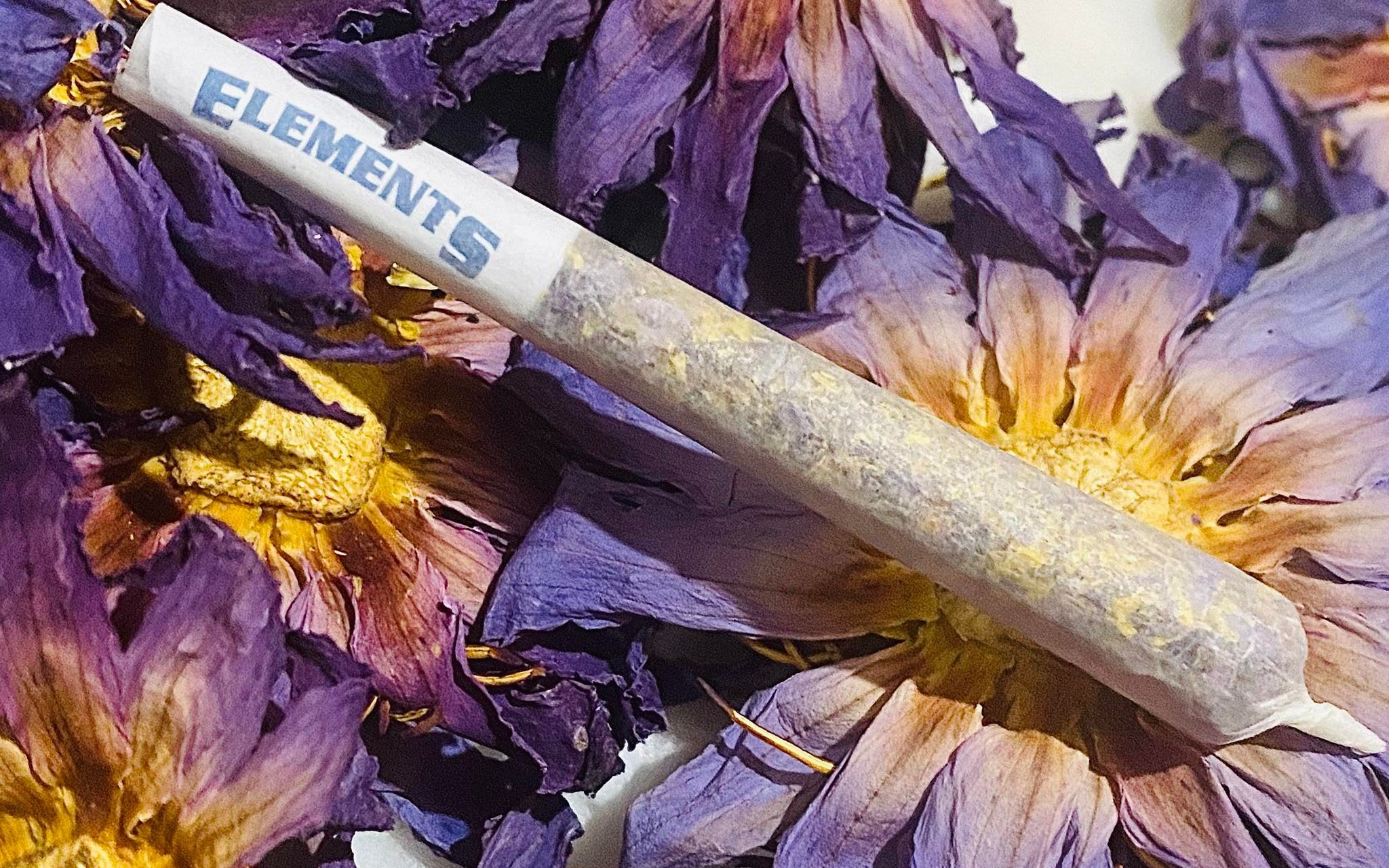In recent years, a mystical flower has been making waves in the world of relaxation and wellness. It’s not cannabis, but it’s closely related in terms of its calming and mood-enhancing properties. Meet Blue Lotus scientifically known as Nymphaea Caerulea, a plant that’s been cherished for millennia, celebrated for its soothing effects, and revered as a sacred flower.
II. What is Blue Lotus

While the name might suggest a connection to the lotus family, this flower is not a lotus at all; it’s a lily. Officially known as the blue water lily, it also goes by the names sacred blue lily of the Nile and Egyptian lotus. With its roots in ancient Egypt, this aquatic perennial has an intriguing history that dates back thousands of years. It was prized for its tranquilizing properties and was used for a variety of purposes, including detoxification, as an aphrodisiac, and for its astringent and diuretic qualities.
But what’s perhaps most captivating about Blue Lotus is its psychoactive potential. In this exploration, we’ll delve deeper into the enchanting world of Blue Lotus, discovering its ancient roots and its contemporary use in conjunction with smoking blends. We’ll also explore the methods of consumption and the unique effects that this captivating flower can offer. So, roll up your sleeves, metaphorically speaking, as we embark on this journey to understand how to smoke Blue Lotus and experience its psychoactive effects.
Traditional Uses in Ancient Egypt

In the land of the pharaohs, Blue Lotus was revered for its multifaceted properties. It was notably associated with rebirth and the cycle of life, paralleling the daily rise and fall of the sun. Ancient Egyptians often incorporated Blue Lotus into their religious ceremonies, believing it to possess divine powers.
The petals of the Blue Lotus were often steeped in wine or other elixirs to create a drink believed to induce a state of heightened awareness and altered consciousness. This ritualistic practice aimed to connect individuals with the spiritual realm, providing insights and enlightenment.
III. Medicinal Properties of Blue Lotus
The enchanting Blue Lotus, known scientifically as Nymphaea caerulea, offers a rich tapestry of medicinal properties that have been appreciated for centuries.
Traditional Uses for Relaxation and Tranquility
Blue Lotus has long held a cherished place in various cultures due to its remarkable ability to induce relaxation and tranquility. Ancient Egyptians, in particular, had a profound connection with this flower. They infused its petals in wine, creating a soothing elixir that was believed to elevate mood, alleviate anxiety, and induce euphoria. In a sense, they harnessed the serene essence of the flower to find solace and mental peace.
Role in Ayurvedic Medicine
In the realms of Ayurvedic medicine, India’s traditional healing system, Blue Lotus is hailed as “Nilotpala” in Sanskrit. It has been utilized for a myriad of medicinal purposes, including:
1. Digestive Aid: Blue Lotus has been embraced for its ability to alleviate digestive discomforts such as dyspepsia, enteritis, and diarrhea. Its astringent properties are thought to assist in regulating digestion.
2. Anti-Pyretic (Fever-Reducing) Agent: Historical records indicate the use of Blue Lotus to reduce fevers. Its cooling properties were believed to provide relief from the discomfort associated with elevated body temperatures.
Scientific Validation
While traditional wisdom provides a strong foundation, scientific research is now unlocking the true potential of Blue Lotus. Recent studies have illuminated its pharmacological properties. This captivating flower contains active compounds, notably apomorphine and nuciferine, which interact with our brain’s dopamine and serotonin systems, impacting mood regulation.
Moreover, Blue Lotus boasts an array of flavonoids, including flavonols, quercetin, kaempferol, and myricetin, renowned for their antioxidant properties. These compounds exhibit remarkable antioxidant activity, contributing to overall health and well-being.
IV. Psychoactive Compounds

Blue Lotus harbors intriguing psychoactive compounds that deserve attention. Two notable constituents are apomorphine and nuciferine.
Apomorphine: This psychoactive alkaloid interacts with both dopamine and serotonin systems, the key neurotransmitters governing pleasure and mood. It contributes to the unique effects attributed to Blue Lotus.
Nuciferine: An alkaloid linked to dopamine receptor blockade, nuciferine acts as a dopamine antagonist, modulating dopamine receptor activity. Its presence in Blue Lotus adds complexity to its psychoactive profile.
Potential Effects on Mood and Relaxation
The interplay of apomorphine and nuciferine can profoundly influence mood and relaxation. Blue Lotus, when used mindfully, may induce a sense of tranquility, contentment, and even mild euphoria. Its effects on the dopamine and serotonin systems offer a window into the flower’s capacity to shape our emotional states.
V. Blue Lotus and Mental Health
Beyond its historical and pharmacological facets, Blue Lotus reveals its potential as a champion of mental well-being. The flower’s interaction with dopamine and serotonin systems comes to the forefront, with implications for stress and anxiety reduction.
Blue Lotus has the capacity to promote mental calmness, ease racing thoughts, and invite a sense of serenity. By modulating neurotransmitters associated with mood, it provides a unique avenue for those seeking emotional balance and resilience in the face of life’s challenges.
In the intricate dance of mind-altering compounds and ancient traditions, Blue Lotus emerges as a promising ally for those embarking on a journey toward inner peace and mental harmony. Its rich history blends seamlessly with its modern scientific allure, making it a captivating subject of exploration and intrigue.
VI. Blue Lotus for Lucid Dreaming
Blue Lotus may hold a captivating key to the realm of lucid dreaming. Lucid dreaming, where dreamers become aware that they’re in a dream, offers unique experiences. Although the scientific connection is not fully explored, anecdotal evidence suggests Blue Lotus may boost the frequency of lucid dreams.
How Blue Lotus Enhances Dreams
The flower’s psychoactive compounds, like apomorphine and nuciferine, influence neurotransmitters such as dopamine and serotonin. This influence may set the stage for vivid and lucid dreaming experiences. Imagine having control over your dreamscape, steering your subconscious narrative – a possibility with Blue Lotus. While more research is needed, this aspect adds to Blue Lotus’s mystique and its potential to unlock the dream world.
VII. Blue Lotus Blends and methods of Consumption

Blue Lotus offers various avenues for consumption, each unveiling its unique charm. Among these, smoking the dried petals is a popular choice. This approach infuses a touch of tranquility into the act of smoking.
One intriguing facet of Blue Lotus is its compatibility with other herbs. Many individuals incorporate it into smoking blends, creating an alluring fusion of flavors
and effects. These blends often encompass a diverse range of herbs, each contributing its essence to the overall experience.
The appeal of Blue Lotus in these blends lies in its potential to enhance relaxation while introducing a subtle, dreamy quality to the smoking ritual. Whether seeking tranquility or aiming to explore its mild psychoactive effects, Blue Lotus offers a unique addition to the world of smoking blends. In the quest for diverse sensory experiences, Blue Lotus stands as an alluring choice.
VIII. How to Smoke Blue Lotus
Smoking or rolling a joint with Blue Lotus can be a captivating experience, but it’s essential to embark on this journey with care and mindfulness. Here’s your guide to get started:
Materials You’ll Need:
Dried Blue Lotus petals: Ensure they are of high quality for the best experience.
Smoking apparatus or rolling papers: Opt for a clean, dedicated pipe or vaporizer for Blue Lotus, or rolling papers if you prefer a joint.
A comfortable setting: Choose a serene, quiet space where you can fully immerse yourself in the experience.
Optional herbs: Some prefer to blend Blue Lotus with other herbs like damiana or mullein for a customized experience.
Step-by-Step Guide for Smoking:

Prepare the Blue Lotus: Start by ensuring your Blue Lotus petals are dried and ready. If not, gently dry them in the sun or using a dehydrator.
Load Your Apparatus: If you’re using a pipe or vaporizer, load it with the dried Blue Lotus petals. Remember, moderation is key. Start with a small amount, roughly 0.1 to 0.5 grams, and adjust as needed.
Ignite and Inhale: Light your smoking apparatus and inhale slowly and deeply. Hold the vapor in your lungs for a few seconds before exhaling.
Create an Atmosphere: As you wait for the effects to unfold, surround yourself with soothing music, calming lighting, or any elements that enhance your experience.
Be Patient: Blue Lotus is known for its gentle, gradual effects. Give it time to weave its magic. You might not experience intense sensations; instead, it often induces a sense of calm, relaxation, and sometimes mild euphoria.
Safety Precautions:
Moderation: While Blue Lotus is generally considered safe, it’s crucial to use it in moderation. Overindulgence can lead to adverse effects.
Avoid Driving: Never drive or operate heavy machinery under the influence of Blue Lotus or any psychoactive substance.
Combining Substances: Be cautious when combining Blue Lotus with other substances, including alcohol or prescription medications. Always consult a healthcare professional if you’re unsure about potential interactions.
Tips for an Optimal Experience:
Set and Setting: Ensure you’re in a peaceful and comfortable environment.
Mindful Consumption: Be mindful of your dosage; start small and increase gradually.
Stay Hydrated: Have water nearby to stay hydrated.
Relax and Enjoy: Approach the experience with an open mind and a spirit of relaxation. Embrace the journey as it unfolds.
By following these guidelines, whether you choose to smoke Blue Lotus in a pipe or roll it into a joint, you can embark on your Blue Lotus journey safely and reap the calming, relaxing, and potentially enlightening benefits it offers.
IX. Blue Lotus Tincture and Tea
While smoking Blue Lotus is a popular choice, alternative methods offer their unique charm. Tinctures and teas provide a gentler, more subtle way to experience the soothing effects of Blue Lotus. Whether you choose the craft of tincture-making or the comforting warmth of Blue Lotus tea, each method invites you to explore the captivating essence of this mystical flower. Select the one that resonates most with your journey and allows you to savor its tranquil embrace.
In this section, we will delve into the enchanting world of Blue Lotus tinctures and teas.
Blue Lotus Tincture:
What You’ll Need:
- Dried Blue Lotus petals
- Alcohol (vodka or brandy)
- A glass jar with a tight-fitting lid
- A strainer or cheesecloth
- A dark-colored glass dropper bottle
Instructions:
Prepare Your Tincture: Begin by obtaining dried Blue Lotus petals. The tincture-making process involves extracting the essence of Blue Lotus using alcohol as the medium. A common ratio is 5 parts alcohol to 1 part dried petals.
Combine and Seal: Place the dried Blue Lotus petals in a glass jar and cover them completely with your chosen alcohol (vodka or brandy). Seal the jar tightly.
Shake and Store: Give the jar a good shake to ensure thorough mixing. Store it in a cool, dark place for 4-6 weeks, remembering to shake it daily. This helps in extracting the active compounds from the petals.
Strain and Transfer: After 4-6 weeks, strain the tincture through a strainer or cheesecloth into a clean jar or bowl. Ensure you capture all the liquid essence.
Bottle It Up: Transfer the strained tincture into a dark-colored glass dropper bottle. Storing it in a cool, dark place ensures its potency remains intact.
Blue Lotus Tea:

What You’ll Need:
- Dried Blue Lotus petals
- Hot water
- A teapot or infuser
- Optional: honey or other sweeteners, herbs, or spices
Instructions:
Prepare the Tea: To create Blue Lotus tea, start by boiling water. While the water heats, place the desired amount of dried Blue Lotus petals in a teapot or infuser. Adjust the quantity based on your preferences.
Steep with Care: Once the water reaches a rolling boil, pour it over the Blue Lotus petals in the teapot or infuser. Cover and steep for approximately 10-15 minutes. Adjust the steeping time to achieve your desired potency.
Sip and Savor: After steeping, pour the tea into your favorite cup. You can enjoy it as is, or enhance the flavor with a touch of honey or other sweeteners, herbs, or spices if desired.
